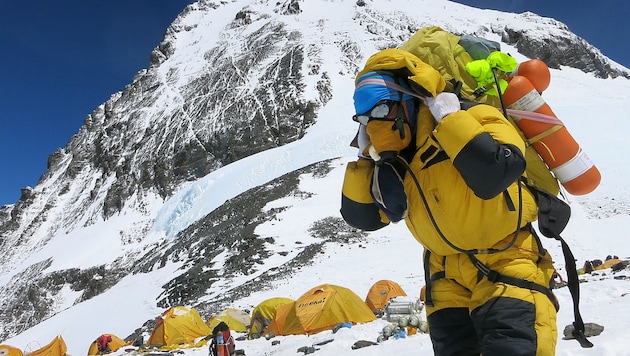Controversial regulation
Mount Everest: Tracking devices become mandatory
With a controversial regulation, the Nepalese authorities want to increase safety on Mount Everest and hundreds of other mountains for which a mountaineering permit is required. In future, all tour participants will be required to carry tracking devices.
The chewing gum-sized reflector from the Swedish company Recco is often sewn into sportswear, works without a battery and can send back a radar signal from a search device from the same company, enabling it to be located - and thus possibly also to rescue fallen climbers.
Regulation after particularly deadly season
The new rule comes into force one year after a particularly deadly mountaineering season in which 18 people died on Everest, which is almost 8850 meters high. The President of the Nepal Mountaineering Association, Nima Nuru Sherpa, welcomes the measure. His and several other expedition organizers are already using Recco reflectors, satellite phones and portable radio transmitters. He emphasizes that Swedish technology has already been used to find missing persons in the Himalayas.
But there are also many critical voices. This is because the tracking devices are particularly suitable for searching for people buried in avalanches in ski resorts and have already saved lives in the Alps. But the detectors can hardly find people who are under boulders or in a deep crevasse - as is often the case with missing persons at 8000 meters in the Himalayas, argue the head of Nepal's largest expedition company Seven Summit Treks, Mingma Sherpa, as well as the US mountaineer and blogger Alan Arnette.
Criticism of "crazy rules"
Arnette compares the search for missing persons with a special helicopter to finding a needle in a haystack. And an expedition organizer in the capital Kathmandu, who wishes to remain anonymous, emphasizes that electronic devices sometimes fail in the harsh conditions on the high mountains: "These crazy rules are made by government employees without any idea."
Arnette has completely different suggestions: Nepal could only allow climbers to go up who have previously climbed a 7,000-meter-high mountain. Or they could stipulate minimum qualifications for mountain guides so that they never leave their clients alone, recognize warning signals early and turn back before they are too late. Or they could limit the size of groups. Many inexperienced people on the mountain would increase the risk of traffic jams and therefore also the risk of death, confirms Nepalese mountain guide Narendra Shahi Thakuri. And especially at altitudes above 8000 meters - the so-called death zone - you should only stay for as short a time as possible, as the body becomes weaker and weaker there and does not recover.
Are wealthy tourists more important than safety?
But such suggestions are likely to fall on deaf ears. After all, the income from the many wealthy tourists is important for the poor Himalayan state. An Everest ascent usually costs at least 40,000 euros per person - often twice that amount.













Kommentare
Willkommen in unserer Community! Eingehende Beiträge werden geprüft und anschließend veröffentlicht. Bitte achten Sie auf Einhaltung unserer Netiquette und AGB. Für ausführliche Diskussionen steht Ihnen ebenso das krone.at-Forum zur Verfügung. Hier können Sie das Community-Team via unserer Melde- und Abhilfestelle kontaktieren.
User-Beiträge geben nicht notwendigerweise die Meinung des Betreibers/der Redaktion bzw. von Krone Multimedia (KMM) wieder. In diesem Sinne distanziert sich die Redaktion/der Betreiber von den Inhalten in diesem Diskussionsforum. KMM behält sich insbesondere vor, gegen geltendes Recht verstoßende, den guten Sitten oder der Netiquette widersprechende bzw. dem Ansehen von KMM zuwiderlaufende Beiträge zu löschen, diesbezüglichen Schadenersatz gegenüber dem betreffenden User geltend zu machen, die Nutzer-Daten zu Zwecken der Rechtsverfolgung zu verwenden und strafrechtlich relevante Beiträge zur Anzeige zu bringen (siehe auch AGB). Hier können Sie das Community-Team via unserer Melde- und Abhilfestelle kontaktieren.